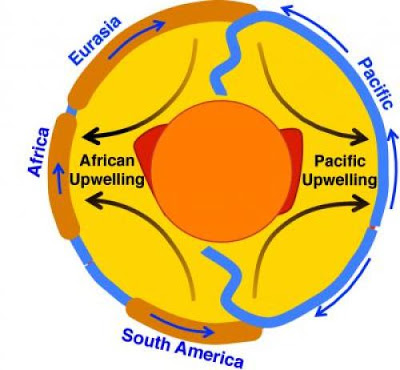
A study published in Nature today shares the discovery that large-scale upwelling within Earth’s mantle mostly occurs in only two places: beneath Africa and the Central Pacific. More importantly, Clinton Conrad, Associate Professor of Geology at the University of Hawaii — Manoa’s School of Ocean and Earth Science and Technology (SOEST) and colleagues revealed that these upwelling locations have remained remarkably stable over geologic time, despite dramatic reconfigurations of tectonic plate motions and continental locations on the Earth’s surface. “For example,” said Conrad, “the Pangaea supercontinent formed and broke apart at the surface, but we think that the upwelling locations in the mantle have remained relatively constant despite this activity.”
Conrad has studied patterns of tectonic plates throughout his career, and has long noticed that the plates were, on average, moving northward. “Knowing this,” explained Conrad, “I was curious if I could determine a single location in the Northern Hemisphere toward which all plates are converging, on average.” After locating this point in eastern Asia, Conrad then wondered if other special points on Earth could characterize plate tectonics. “With some mathematical work, I described the plate tectonic ‘quadrupole’, which defines two points of ‘net convergence’ and two points of ‘net divergence’ of tectonic plate motions.”
When the researchers computed the plate tectonic quadruople locations for present-day plate motions, they found that the net divergence locations were consistent with the African and central Pacific locations where scientists think that mantle upwellings are occurring today. “This observation was interesting and important, and it made sense,” said Conrad. “Next, we applied this formula to the time history of plate motions and plotted the points — I was astonished to see that the points have not moved over geologic time!” Because plate motions are merely the surface expression of the underlying dynamics of the Earth’s mantle, Conrad and his colleagues were able to infer that upwelling flow in the mantle must also remain stable over geologic time. “It was as if I was seeing the ‘ghosts’ of ancient mantle flow patterns, recorded in the geologic record of plate motions!”
Earth’s mantle dynamics govern many aspects of geologic change on the Earth’s surface. This recent discovery that mantle upwelling has remained stable and centered on two locations (beneath Africa and the Central Pacific) provides a framework for understanding how mantle dynamics can be linked to surface geology over geologic time. For example, the researchers can now estimate how individual continents have moved relative to these two upwelling locations. This allows them to tie specific events that are observed in the geologic record to the mantle forces that ultimately caused these events.
More broadly, this research opens up a big question for solid earth scientists: What processes cause these two mantle upwelling locations to remain stable within a complex and dynamically evolving system such as the mantle? One notable observation is that the lowermost mantle beneath Africa and the Central Pacific seems to be composed of rock assemblages that are different than the rest of the mantle. Is it possible that these two anomalous regions at the bottom of the mantle are somehow organizing flow patterns for the rest of the mantle? How?
“Answering such questions is important because geologic features such as ocean basins, mountains belts, earthquakes and volcanoes ultimately result from Earth’s interior dynamics,” Conrad described. “Thus, it is important to understand the time-dependent nature of our planet’s interior dynamics in order to better understand the geological forces that affect the planetary surface that is our home.”
The mantle flow framework that can be defined as a result of this study allows geophysicists to predict surface uplift and subsidence patterns as a function of time. These vertical motions of continents and seafloor cause both local and global changes in sea level. In the future, Conrad wants to use this new understanding of mantle flow patterns to predict changes in sea level over geologic time. By comparing these predictions to observations of sea level change, he hopes to develop new constraints on the influence of mantle dynamics on sea level.
Note: The above story is reprinted from materials provided by University of Hawaii at Manoa, via EurekAlert!, a service of AAAS.










